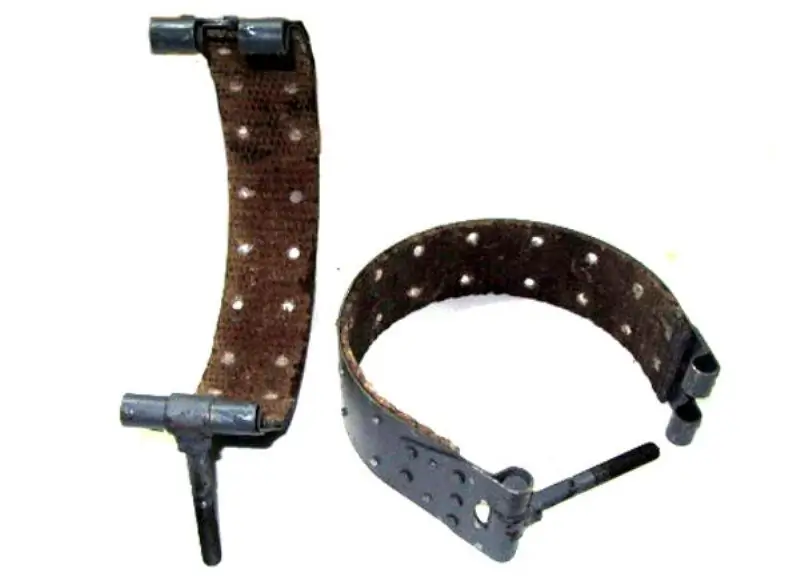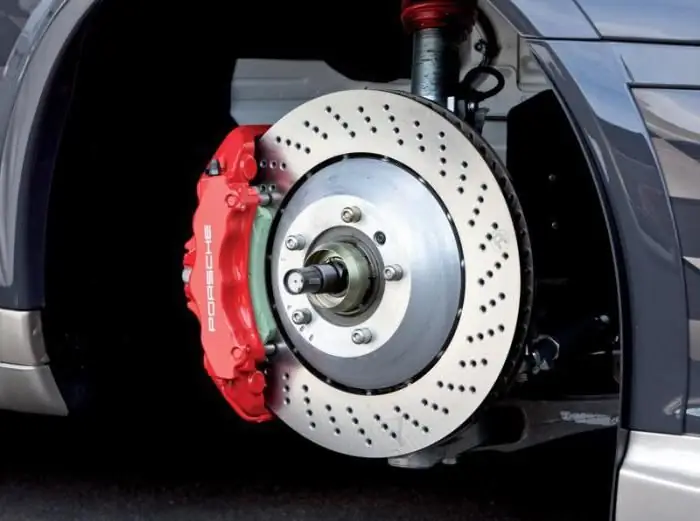2026 Author: Erin Ralphs | [email protected]. Last modified: 2025-01-22 21:14:09
The brake system of "Ural" includes four main units: working, emergency, parking and auxiliary units. Each of the systems works independently, and therefore the failure of any brake does not adversely affect the operation of the associated devices, which guarantees additional safety and reliability of the entire structure.

Ural brake system device
The node under consideration is focused on ensuring a smooth stop of the truck with deceleration or completely. Efficiency does not depend on the speed of movement before braking, terrain features, road surface and other subjective and objective factors.
Ural brakes are equipped with a mixed pneumohydraulic drive with a pair of circuits. The design is responsible for slowing down all six wheels along with the trailer. In this case, the front and rear elements brake separately on the axles. The process itself is activated by pressing the pedal from the driver's cab. Movable leveraggregates with a two-section stopcock through connecting rods and fixing parts.
Ural's working brake system consists of the following elements:
- wheel cylinder, two parts of which are placed in one housing;
- brake shield;
- adjustable eccentric adjustable with turn screw and wrench;
- pads located on the axes of supports;
- friction type linings;
- connecting parts in the form of valves, hose, holders.

Brake Master Cylinder
This part is responsible for controlling the working system of the truck. Increased reliability is provided by two elements equipped with pneumatic amplifiers. The principle of operation of the Ural brake system is that the opening of the valve in the shut-off valve occurs after pressing the pedal in the driver's cab. Air masses enter through special channels and holes into the piston of the intensifying pneumatic unit.
The second piston is supplied with air through radial sockets in the rod. Under pressure, all incoming masses act on the main cylinder, which displaces fluid into the TM (brake line). When the machine is released from the brakes, the air is vented to the atmosphere through the stopcock. In this case, the pistons of the HC and the pneumatic booster return to their original position. The front analogues are equipped with indicators that notify of possible problems in the car's brakes.
Features
Ural brake systemequipped with drum mechanisms that are completely interchangeable. The pneumatic design itself forms separate brake compartments for various parts of the machine (trailer, front, rear axle). In the event of a malfunction in one segment, the analogues remaining in operation are responsible for braking.
Below is a diagram of the master cylinder with explanations.

- Front air cylinder.
- Space element.
- Radial socket.
- Rear air cylinder.
- Stock.
- Coupling screw.
- Nuts.
- Indicator.
- Main cylinder.
- Cork.
- Brake fluid reservoir.
Parking gear
Ural's hand brake system is designed to stop the car during parking on slopes and rises. During the movement, the mechanism is used only in emergency cases. The working drive of the assembly is mechanical, the lever is located on the side of the driver's seat on the right. This element aggregates with a trailed analogue, when it is raised to the upper position, it also activates the trailer stop device.
Ural parking brake action:
- raising the lever causes the force to be applied to the main structure, bypassing the intermediate point;
- from the lever element, the impulse passes through the bar to the block (to the left or right, depending on the rotation of the drum);
- the block is unhooked from the connection pin and rotated in the direction of travel, pressing the secondshoe part.
Auxiliary brake
Ural's additional brake system is designed to keep the car on long descents. The controller key is located on the floor of the control cabin. Pressing it organizes the following processes:
- compressed air is supplied to pneumatic cylinders;
- flow affects pistons and moves them;
- these elements close the flaps, which creates an opposite pressure that provides braking force;
- synchronously the impulse is transformed into the brake structure of the trailer.
Brake valve drive
The brake valve drive device with a description of the elements is given below.

- Operating pedal.
- Lever.
- Adjusting screw.
- Traction fork.
- Fixing nut.
- Drive rod.
- Brake valve lever.
- Bracket.
The safety valve must be corrected if it does not maintain the pressure in the brake system of the Ural at the given positions. Adjustment is carried out by turning the corresponding screw. In this case, the pressure indicator rises, and after reaching the required parameter, the adjustment bolt is fixed with a nut. To avoid air leakage, the valve is removed, washed and cleaned (in kerosene). Workstations are washed with soapy water and checked for wear and deformation.
Adjustment and pumping
Bleeding the brake system "Ural" withsimultaneous adjustment is carried out as follows:
- Using a special key, turn the eccentrics of both brake pads until they stop.
- The left analog is rotated counterclockwise, the right element is rotated in the direction of travel.
- Then, the eccentrics are loosened by turning the axial screw head 50% in the opposite direction.
- These steps must be repeated for all wheels.
- Check whether the adjustment is correct by evaluating the heating of the drums while the vehicle is moving. Carrying out the specified procedure, it is necessary to observe the ratio of the factory location of the brake pads to the support axles. The gaps are corrected by turning the axes with the introduction of a special shunting device into them, which is 20 cm long and the thickness varies from 0.2 to 0.35 mm. Covers that are excessively oily are treated with gasoline.

Pneumohydraulic drive
Ural's air brake system is a mixed unit that includes not only pneumatics, but also hydraulic mechanisms. The block consists of a pair of working circuits (for front and rear wheels).
The main two brake circuits of the specified truck include:
- atmospheric cylinders of various configurations, which are placed parallel to each other;
- brake crane, the upper part of which belongs to the first office, and the second compartment - to the second;
- pneumatic brake booster with cylinder wheel;
- work force regulator.
Recommendations
The third circuit has a separate air reservoir, special valves to control the operation of the trailer wheels. It also includes connecting heads that differ in configuration, depending on which drive they are intended for. The third circuit is responsible for stopping the trailer.
The compressor works in conjunction with a regulator that sends an air stream to safety valves that distribute the resulting mixture between all tanks in each circuit compartment. All chambers are equipped with pressure gauges that allow you to control the pressure indicator.

Ural braking system malfunctions
Among the problems of this design, there are several faults that occur most often in practice:
- weak buildup of pressure in receivers due to breakage of main housings or connections;
- filling the balloon circuits in insufficient volume, which provokes the failure of the corrective valves or excessive contamination of the associated nodes;
- low pressure in trailer air tanks, most commonly caused by cracked parts;
- overpressure in the receivers due to a malfunction of the controller or pressure gauge;
- compression failure, indicating serious wear on the compressor piston unit.
If critical malfunctions occur in the specified system, operate the carAbsolutely forbidden. The problem should be corrected on site or the machine should be taken to a workshop using a rigid hitch type linkage.

Repair work
When repairing parts of the Ural brake system, all devices and elements should be carefully removed, washed thoroughly and carefully checked for defects. The assembly is disassembled as follows:
- Using a jack, lift the serviced axle, remove the wheel and hub cap, and then unscrew the tire inflation square by dismantling the axle shaft using a puller.
- Bend the washer-stopper and the outer latch, take out the lock and inner washer.
- The hub and the brake drum are dismantled together with bearings, retaining clips, shoe springs. The bushing and pad pin are thoroughly cleaned.
- Unscrew the pipeline with bolts, remove the wheel-type cylinder, remove the shoe bearings.
- Dismantle the brake shield and felt seal.
- When dismantling the main shopping center, do not unscrew the plug.
- It is recommended to disassemble the compressor HC only in case of emergency. It is pressed out using a special puller.
- All oily and contaminated parts of the brake system of the Ural car are washed in gasoline. If the distance from the surface of the pads to the rivet heads is less than 0.5 mm, the parts must be replaced with new modifications.
- Hand brake shoe elements are processed together with the expanding cam.
- Drums with circumferential grooves more than 2mm deep need to be machined.
- It would be useful to honing wheel cylinders that show signs of corrosion and abrasions. Items showing excessive wear should be replaced.
Recommended:
Band brake: device, principle of operation, adjustment and repair

The brake system is designed to stop various mechanisms or vehicles. Another purpose is to prevent movement when the instrument or machine is at rest. There are several varieties of these devices, among which the band brake is one of the most successful
Brake system: device and principle of operation

The brake system is the most important unit in the operation of every modern car. The safety of the driver and his passengers directly depends on the efficiency of its work and good condition. Its main function is to control the speed of the vehicle, braking and stopping as needed
ABS system. Anti-blocking system: purpose, device, principle of operation. Bleeding brakes with ABS

Not always an inexperienced driver manages to cope with the car and quickly reduce the speed. You can prevent skidding and blocking of the wheels by intermittently applying the brake. There is also an ABS system, which is designed to prevent dangerous situations while driving. It improves the quality of grip with the roadway and maintains the controllability of the car, regardless of the type of surface
The principle of operation of the variator. Variator: device and principle of operation

The beginning of the creation of variable programs was laid in the last century. Even then, a Dutch engineer mounted it on a vehicle. After such mechanisms were used on industrial machines
"Lada-Kalina": ignition switch. Device, principle of operation, installation rules, ignition system, advantages, disadvantages and features of operation

Detailed story about the ignition switch Lada Kalina. General information and some technical characteristics are given. The device of the lock and the most frequent malfunctions are considered. The procedure for replacing with your own hands is described

